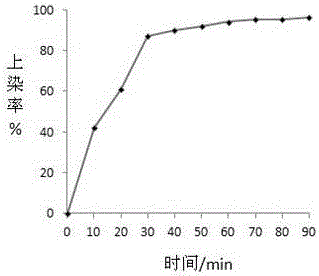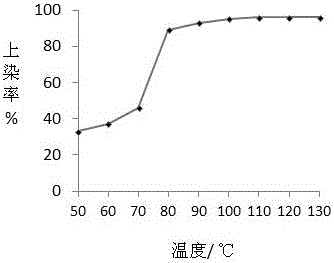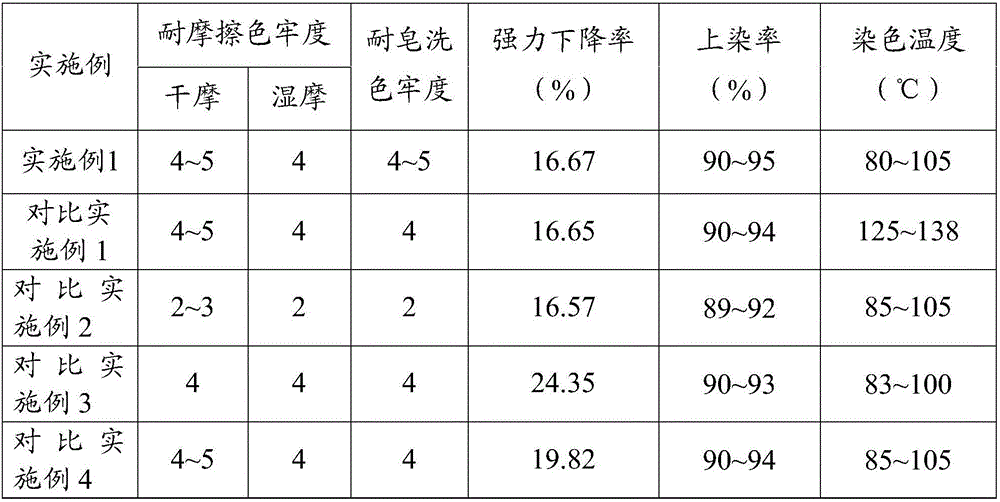Dyeing process of polyester blended fabric
A technology of blended fabrics and polyester, applied in dyeing, textiles and papermaking, etc., can solve the problems of low dyeing rate, poor level dyeing property, and low color fastness of polyester blended fabrics, and achieve improved dyeing rate and softness , the effect of reducing the dyeing temperature
- Summary
- Abstract
- Description
- Claims
- Application Information
AI Technical Summary
Problems solved by technology
Method used
Image
Examples
preparation example Construction
[0031] The invention provides a method for preparing a polyester blended fabric dyeing liquid, comprising the following steps:
[0032] (1) Preparation of dyeing solution:
[0033] a. Add deionized water to the mixed powder of cobalt sulfate, ferrous sulfate and sodium sulfate, keep the temperature at 30-55°C, and stir for 0.5-1.5 hours;
[0034] b. In the material obtained in step (1), first add glycerin and mix evenly, then add diphenyl ether tetra-acid dianhydride, fatty alcohol polyoxyethylene ether, trimethylolpropane, acetanilide and ethylenediaminetetraacetic acid di sodium, maintain the temperature at 40-65°C, and treat for 1.5-4 hours;
[0035] c. Adding catalyst, modifying agent, diffusing agent and surfactant to the material obtained in step (2), maintaining the temperature at 25-40° C., and ultrasonically reacting for 0.5-2 hours.
[0036] (2) Dyeing treatment:
[0037] a. Pretreat the polyester blended fabric first;
[0038] b. Then immerse the pretreated poly...
Embodiment 1
[0053] The polyester blended fabric used in this embodiment of the present invention is a blended fabric of polyester and wool, wherein the weight ratio of polyester is 60%, and the medicines used are all calculated in parts by weight.
[0054] A kind of polyester blended fabric dyeing process of the present invention comprises the following steps:
[0055] (1) Preparation of dyeing solution:
[0056] a. Take 0.5 parts of cobalt sulfate, 1 part of ferrous sulfate, 0.5 parts of sodium sulfate, add 10 parts of deionized water, and stir for 0.5 hours at a temperature of 35 °C;
[0057] b. In the material obtained in step a, first add 3 parts of glycerin and mix evenly, then add 3 parts of diphenyl ether tetraacid dianhydride, 2 parts of fatty alcohol polyoxyethylene ether, 3 parts of trimethylolpropane, and 4 parts of acetanilide 2 parts, 2 parts of ethylenediaminetetraacetic acid disodium, maintain the temperature at 45°C, and treat for 2h;
[0058] c, add 1 part of transgluta...
Embodiment 2
[0067] The polyester blended fabric used in this embodiment of the present invention is a blended fabric of polyester, wool and acetate fiber, wherein the weight ratio of polyester is 65%, and the medicines used are all calculated by parts by weight.
[0068] A kind of polyester blended fabric dyeing process of the present invention comprises the following steps:
[0069] (1) Preparation of dyeing solution:
[0070] a. Take 1 part of cobalt sulfate, 1.5 parts of ferrous sulfate, 0.8 parts of sodium sulfate, add 10 parts of deionized water, and stir for 1 hour at a temperature of 38°C;
[0071] b. In the material obtained in step (1), first add 4 parts of glycerin and mix evenly, then add 4 parts of diphenyl ether tetra-acid dianhydride, 3 parts of fatty alcohol polyoxyethylene ether, 4 parts of trimethylolpropane, acetyl 3 parts of aniline, 4 parts of di-sodium edetate, maintain the temperature at 50°C, and treat for 2.5 hours;
[0072] c. Add 2 parts of transglutaminase, 1 ...
PUM
 Login to View More
Login to View More Abstract
Description
Claims
Application Information
 Login to View More
Login to View More - R&D
- Intellectual Property
- Life Sciences
- Materials
- Tech Scout
- Unparalleled Data Quality
- Higher Quality Content
- 60% Fewer Hallucinations
Browse by: Latest US Patents, China's latest patents, Technical Efficacy Thesaurus, Application Domain, Technology Topic, Popular Technical Reports.
© 2025 PatSnap. All rights reserved.Legal|Privacy policy|Modern Slavery Act Transparency Statement|Sitemap|About US| Contact US: help@patsnap.com



